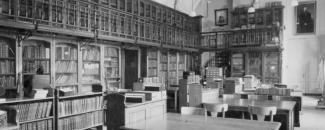Extension of the original library in the 19th century
Very soon after the university moved into the former convent, important works were launched. Around 1820, Jean-Noël Chevron, who was responsible for building the new university, laid out the plans for new buildings. The library wing was extended by adding four sections to the existing ones, along with an amphitheatre for anatomy lessons.
Starting in 1835, following the increase in the student population and the collections, new works became necessary. The refurbishment and construction of new buildings were entrusted to Julien-Étienne Rémont on this occasion. They kept the sections that were added to the Jesuit building by Chevron and demolished the medical amphitheatre. Rémont completed the wing in the same style as the 18th century construction, retaining a perfect symmetry. At this time, the building’s ground floor was occupied by the philosophy, law and medicine auditoriums, as well as the botanical museum in the central part of the Faculty of Medicine building.
These changes considerably increased the library’s surface area, which now occupied the whole first floor. Three large, decorated rooms were built. These were connected to each other by Corinthian column arcades, with vaulted roofs decorated with caissons.
The axonometrical section of the building, and the plans that were published in the 1869 Liber Memorialis, make it possible to locate the library departments and give an idea of the developments that occurred in 1836. They also show its extensions, which were built between 1842 and 1869, into the building on Place Cockerill, where the music room and a room with six columns are found. The chief librarian’s office and the reading room were located in the Paquay Barbière wing. At this time, the library’s collections were once again restricted by limited space. A few years beforehand, Fiess had refurbished the former reading room above the amphitheatre so that part of the collections (manuscripts, sheet music, engravings and the medal cabinet) could be stored there, but these spaces were already full when Leroy wrote the Liber memorialis in 1869. The situation seems to have remained the same until the beginning of the 20th century. In 1903, Adrien Witter’s willed his collections to the university, which considerably increased the library’s collection. Some twenty thousand works, including manuscripts, incunabula and many old prints, enhanced the collections, in addition to a set of remarkable drawings and etchings, objets d'art and fifty paintings. This unexpected bequest soon became a problem. From 1904, the cataloguing of books was interrupted by a lack of space in the rooms.

